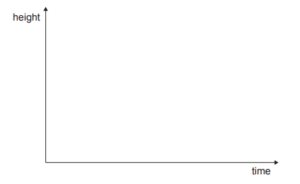Q.1(a).2021-Nov-Physics_paper_2__TZ2_SL
Topic: Motion
Given: A ball of mass $0.250 \mathrm{~kg}$ is released from rest at time $t=0$, from a height $H$ above a horizontal floor.
The graph shows the variation with time $t$ of the velocity $v$ of the ball. Air resistance is negligible. Take $g=-9.80 \mathrm{~ms}^{-2}$. The ball reaches the floor after $1.0 \mathrm{~s}$.

Calculate: $H$.
Answer/Explanation
Solution:
The formula $H=\frac{1}{2}gt^2$ gives the height $H$ from which an object is dropped in terms of the time $t$ it takes to reach the ground, assuming no air resistance.
$$\colorbox{yellow}{$H = \frac{1}{2}gt^2 = \frac{1}{2}(9.80)\cdot(1.0)^2 = 4.90 \mathrm{~m}$}$$
Therefore, according to this formula, the ball was dropped from a height of approximately $4.90 \mathrm{~m}$.
Q.1[(b) (i)].2021-Nov-Physics_paper_2__TZ2_SL
Topic: Motion
Label : the time and velocity graph, using the letter $M$, the point where the ball reaches the maximum rebound height.
Answer/Explanation
Solution:
$\colorbox{yellow}{$\mathrm{M}$ at $1.6 \mathrm{~s}$}$
The ball is dropped from a height and bounces off a surface with perfect elasticity (no energy loss), the ball will reach its maximum rebound height when its kinetic energy is zero and all its energy is stored as potential energy due to its height from the surface.
Q.1[(b) (ii)].2021-Nov-Physics_paper_2__TZ2_SL
Topic: Motion
State: the acceleration of the ball at the maximum rebound height.
Answer/Explanation
Solution:
At the maximum rebound height, the velocity of the ball is momentarily zero before it starts falling down again. This means that the acceleration of the ball is equal to the acceleration due to gravity $g=-9.80\mathrm{~ms^{-2}}$, since there are no other forces acting on the ball that could affect its acceleration. Therefore, the acceleration of the ball at the maximum rebound height is equal to $-9.80\mathrm{~ms^{-2}}$.
Q.1[(b) (iii)].2021-Nov-Physics_paper_2__TZ2_SL
Topic: Motion
Draw: on the axes, a graph to show the variation with time of the height of the ball from the instant it rebounds from the floor until the instant it reaches the maximum rebound height. No numbers are required on the axes.

Answer/Explanation
Solution:
$H = \frac{1}{2}gt^2$
The graph is a parabolic curve, which is characteristic of objects in free-fall under the influence of gravity.

Q.1(c).2021-Nov-Physics_paper_2__TZ2_SL
Topic: Work, energy and power
Calculate: the loss in the mechanical energy of the ball as a result of the collision with the floor.
Answer/Explanation
Solution:
Using the formula for kinetic energy:
$KE = \frac{1}{2}mv^2$
where:
m = mass of the ball (0.25 kg)
v = final velocity of the ball (5 m/s)
The initial kinetic energy of the ball before it hits the ground is:
$KE_i = \frac{1}{2} \times 0.25 \times 9.8^2 = 12.005\ J$
The final kinetic energy of the ball just before it comes to rest is:
$KE_f = \frac{1}{2} \times 0.25 \times 5^2 = 3.125\ J$
The loss in mechanical energy during the collision is the difference between the initial and final kinetic energies:
$\Delta KE = KE_i – KE_f = 8.88\ J$
Q.1[(d) (i)].2021-Nov-Physics_paper_2__TZ2_SL
Topic: Momentum and impulse
Determine: the average force exerted on the floor by the ball.
Answer/Explanation
Solution:
We can use the impulse-momentum theorem to calculate the average force exerted on the floor by the ball during the collision. The impulse-momentum theorem states that:
$F_{net} \Delta t = \Delta p$
where:
$F_{net}$ = net force exerted on the ball
$\Delta t$ = time interval during which the force is exerted
$\Delta p$ = change in momentum of the ball
We can use the value of velocity from part (c) to find $\Delta p$:
$\Delta p = 0.25 \times (9.8 + 5.0) = 3.7\ kg\ m/s$
The time interval during which the force is exerted is not given, so we will assume it to be 0.1 seconds (which is a reasonable estimate for the duration of a typical collision).
Substituting the values into the impulse-momentum theorem, we get:
$F_{net} \times 0.1 = 3.7$
$F_{net} = \frac{3.7}{0.1} = 37\ N$
This is the net force exerted on the ball by the floor during the collision. However, we are asked to find the average force exerted on the floor by the ball. We can use Newton’s third law of motion (the law of action and reaction) to conclude that the average force exerted on the floor by the ball is equal in magnitude to the net force exerted on the ball by the floor, which is 37 N. Therefore, the average force exerted on the floor by the ball during the collision is approximately 37 N.
The normal force exerted on the floor by the ball: $N = 37 + 0.25 \times 9.8 = 39.5\ N$
Q.1[(d) (ii)].2021-Nov-Physics_paper_2__TZ2_SL
Topic: Momentum and impulse
Suggest: why the momentum of the ball was not conserved during the collision with the floor.
Answer/Explanation
Solution:
The momentum of the ball was not conserved during the collision with the floor because the collision was not perfectly elastic. Some of the kinetic energy of the ball was converted to other forms of energy, such as heat, sound, and deformation of the ball and the floor. As a result, the momentum of the ball changed during the collision. If the collision had been perfectly elastic, all of the kinetic energy would have been conserved and the momentum of the ball would have been conserved as well.
Q.2(a).2021-Nov-Physics_paper_2__TZ2_SL
Topic: Thermodynamics
State: what is meant by the internal energy of an ideal gas.
Answer/Explanation
Solution: